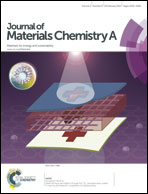A novel route for the facile synthesis of hierarchically porous TiO2/graphitic carbon microspheres for lithium ion batteries†
Abstract
Hierarchically porous titanium dioxide/graphitic carbon microspheres (xTiO2/GCM, x = 0, 10.0, 20.0, 30.0 and 40.0) are synthesized for the first time by a simple colloidal crystal templating method. The properties of the samples are characterized by X-ray diffraction (XRD), energy dispersive spectroscopy (EDS), nitrogen adsorption–desorption (BET), scanning electron microscopy (SEM), and transmission electron microscopy (TEM) analysis techniques. SEM images show that all the samples have similar particulate morphologies and that the particle sizes are about 1 μm. It is observed that the amount of acetone solvent used greatly influenced the morphology of the composites. The obtained TiO2/GCM composite microspheres possess hierarchical porosity with a large specific surface area, high metallic compound content, and graphitic carbon frameworks. Employing these characteristics and advantages, the as-prepared hierarchical porous TiO2/graphitic carbon microsphere samples were used to fabricate lithium ion batteries (LIBs) as the active anode materials and their corresponding lithium ion insertion/extraction performance is evaluated. The resultant LIBs of the TiO2/GCM composites possess a more stable cyclic performance, larger reversible capacity, and better rate capability, compared with that of the graphitic carbon microspheres. Sample 20TiO2/GCM exhibited a higher specific capacity and better cycling performance and rate capability than other samples.


 Please wait while we load your content...
Please wait while we load your content...